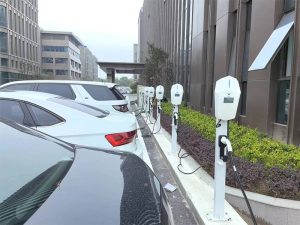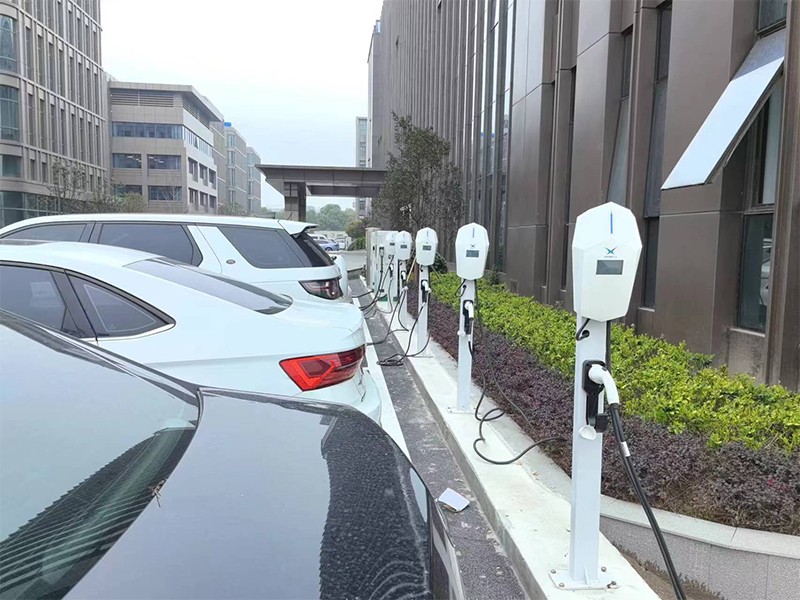As electric vehicles (EVs) gain popularity, the demand for advanced charging infrastructure continues to grow. EV chargers with payment terminals are innovative solutions that allow users to pay for charging directly at the station using credit cards, mobile wallets, or other cashless methods. These chargers not only provide convenience for EV owners but also create revenue opportunities for businesses. This article explores the definition, functionality, benefits, key features, top products, installation, maintenance, costs, return on investment (ROI), future trends, and FAQs about EV chargers with payment terminals, offering a comprehensive guide to this technology and its role in the EV ecosystem.

What is an EV Charger with a Payment Terminal?
An EV charger with a payment terminal is a charging station equipped with a point-of-sale (POS) system, enabling users to pay for charging sessions without cash. These terminals typically support multiple payment methods, including:
-
Credit and debit cards
-
Mobile wallets (e.g., Apple Pay, Google Pay)
-
Prepaid cards or loyalty programs
These chargers are primarily used in public and commercial settings, such as parking lots, gas stations, shopping malls, and office buildings. By offering seamless payment options, they enhance the user experience while providing operators with data collection and revenue-generating opportunities.
How Do EV Chargers with Payment Terminals Work?
Using an EV charger with a payment terminal is straightforward. Here’s a typical process:
-
Connect the Vehicle: The user plugs their EV into the charging station’s connector.
-
Select Payment Method: Via the terminal’s touchscreen or keypad, the user selects a payment method, such as a credit card or mobile wallet.
-
Process Transaction: The payment terminal securely processes the transaction, initiating the charging session.
-
Charge: The vehicle begins charging, and the user can wait or engage in other activities.
-
Completion and Receipt: Once charging is complete, the user can opt for a receipt, with some terminals offering digital receipts.
These chargers are often integrated with charging networks and management systems, supporting real-time monitoring and multilingual interfaces. For example, the JSOWELL ev charger supports over 30 languages, ensuring accessibility for global users.
Benefits of EV Chargers with Payment Terminals
EV chargers with payment terminals offer numerous advantages for both EV owners and station operators:
-
User Convenience: No need for cash or multiple charging apps; users can pay directly at the station.
-
Revenue Stream: Businesses can generate income by selling electricity, similar to gas station models.
-
Broad Accessibility: Multiple payment methods attract a wider user base, including those without smartphones.
-
Data Insights: Operators can collect usage data to optimize infrastructure and improve services.
-
Market Appeal: Locations offering charging (e.g., malls or parking lots) can attract more EV users, increasing foot traffic.
Key Features to Consider When Choosing an EV Charger with a Payment Terminal
When selecting an EV charger with a payment terminal, the following features are critical:
|
Feature |
Description |
|---|---|
|
Multiple Payment Options |
Supports credit/debit cards, mobile wallets, prepaid cards, etc., to cater to diverse users. |
|
User-Friendly Interface |
Intuitive touchscreen or keypad for easy operation and minimal learning curve. |
|
Durability |
Outdoor chargers require waterproof (e.g., IP55 rating) and vandal-resistant designs. |
|
Integration |
Compatible with charging networks and software for remote monitoring and analytics. |
|
Security |
Encrypted payment processing to protect user data, compliant with PCI PTS standards. |
|
Reporting & Analytics |
Provides usage data and reports to help businesses optimize operations and revenue. |
Top EV Chargers with Payment Terminals on the Market
Here are some leading EV chargers with payment terminals, based on their features and applicability:
-
JSOWELL (EV Meter):
-
Features: Built-in payment terminal, supports over 30 languages, compatible with all plug-in EVs.
-
Use Case: Indoor and outdoor, IP55 certified, ideal for parking lots and commercial venues.
-
Advantages: Supports multiple payment methods, including prepaid cards, suitable for gated environments.
-
-
XCP Corporation Credit Card Payment System (XCP Corporation):
-
Features: Fast, secure transaction processing, supports various payment methods.
-
Use Case: Public charging stations, such as shopping centers and gas stations.
-
Advantages: Seamless integration with charging networks, simplifying user experience.
-
-
IOCharger IOCAP26 (IOCharger):
-
Features: OCPP 2.0.1 compliant, built-in POS terminal, can charge two vehicles simultaneously (up to 22kW per connector).
-
Use Case: Commercial parking lots, gas stations, and curbside stations.
-
Advantages: IP55 and IK10 protection ratings, ideal for high-traffic outdoor environments.
-
Installation and Maintenance
Installation
-
Professional Requirements: Installation requires a licensed electrician to ensure safety and compliance with local regulations (e.g., electrical permits).
-
Cost: Installation fees typically range from $500 to $2,000, depending on electrical upgrades and permit costs.
-
Considerations: Choose UL- or ETL-certified chargers for long-term reliability.
Maintenance
-
Regular Inspections: Ensure the charger functions properly, checking cables and the terminal’s physical condition.
-
Software Updates: Regularly update payment terminal and charging management software for security and functionality.
-
Cleaning: Especially for outdoor chargers, periodic cleaning prevents dust and debris buildup.
Costs and Return on Investment (ROI)
Costs
-
Equipment Cost: Basic models start at around $1,000, with advanced models costing several thousand dollars.
-
Installation Cost: $500 to $2,000, depending on electrical system complexity and permit fees.
-
Operational Costs: Include electricity, maintenance, and network connectivity fees.
Return on Investment
-
Revenue Potential: At $10 per charge and 10 charges daily, a charger could generate approximately $36,500 annually (after deducting electricity and maintenance costs).
-
Incentives: Some regions offer tax credits or rebates, such as the U.S. federal tax credit covering a portion of installation costs (IRS).
Choosing the Right Charger
When selecting an EV charger with a payment terminal, evaluate based on specific needs:
-
Use Case: High-traffic areas (e.g., malls) require high-output, durable chargers.
-
Location: Outdoor chargers need waterproofing, while indoor chargers have lower requirements.
-
Payment Methods: Ensure support for payment methods preferred by your target users.
-
Scalability: For expanding charging networks, choose systems that are easy to upgrade.
-
Support Services: Opt for brands with strong customer support and maintenance services.
Future Trends
EV chargers with payment terminals are evolving rapidly. Here are some future trends:
-
Advanced Payment Methods: Biometric authentication (e.g., fingerprint or facial recognition) will enhance security.
-
Vehicle-to-Grid (V2G): Chargers may support EVs feeding energy back to the grid.
-
Enhanced Connectivity: IoT integration for real-time monitoring and control will improve user experience.
-
Standardization: Unified payment methods across networks will simplify operations for users.
Frequently Asked Questions
-
What payment methods are supported?
Most terminals support credit/debit cards and mobile wallets, with some offering prepaid cards or loyalty programs. -
Can these be installed at home?
While possible, they are more common in public or commercial settings. Home chargers typically don’t require payment terminals unless used for shared charging. -
How secure are the payments?
Reputable chargers use encrypted processing, similar to ATMs or online transactions, to protect user information. -
Is a dedicated app required?
Some chargers support apps for additional features, but basic use typically doesn’t require one. -
How long does charging take?
Charging time varies by charger type and vehicle battery capacity. Level 2 chargers take 4-10 hours, while Level 3 (DC fast chargers) take 30 minutes to 1 hour.
Conclusion
EV chargers with payment terminals are a vital component of the EV charging infrastructure, offering convenience for users and revenue opportunities for businesses. By understanding their functionality, benefits, key features, and top products, you can make informed decisions, whether installing a charger for a commercial venue or providing charging services for a community. As the EV market continues to grow, these chargers will play an increasingly critical role in supporting sustainable transportation.


